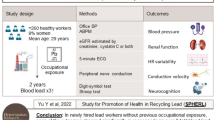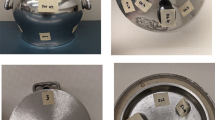Abstract
In the present study, the environmental and occupational exposure of lead (Pb) has been assessed by analyzing the whole-blood samples of early adolescents (boys) aged 12–15 years working for the past 1–3 years in battery recycling workshops (BRW). For comparative purpose, boys of the same age group residing in the vicinity of BRW (exposed non-workers) and who lived in domestic areas devoid of any industrial activity (referents boys) were selected. The blood samples were analyzed for Pb, along with biochemical parameters of blood. Both biological samples were oxidized by acid in a microwave oven before determination of Pb by graphite furnace atomic absorption spectrometry. The mean value of Pb concentration in blood samples of working boys was threefold higher as compared with referent boys. The significant negative correlations of blood Pb level with % Hb (r=−0.862) were observed in working boys.
This is a preview of subscription content, access via your institution
Access options
Subscribe to this journal
Receive 6 print issues and online access
$259.00 per year
only $43.17 per issue
Buy this article
- Purchase on Springer Link
- Instant access to full article PDF
Prices may be subject to local taxes which are calculated during checkout
Similar content being viewed by others
References
Pokras M.A., and Kneeland M.R. Lead poisoning: using transdisciplinary approaches to solve an ancient problem. Ecohealth 2008: 5: 379–385.
Parry J. Metal smelting plants poison hundreds of Chinese children. BMJ 2009: 339: b3433.
Khan D.A., Qayyum S., and Saleem S., et al. Lead exposure and its adverse health effects among occupational worker's children. Toxicol Ind Health 2010: 26: 497–504.
Jarosinska D., Peddada S., and Rogan J. Assessment of Pb exposure and associated health risk factors in urban children in Silesia, Poland. Environ Res 2004: 95: 133–142.
Mansouri M.T., and Cauli O. Motor alterations induced by chronic Pb exposure. Environ Toxicol Pharmacol 2009: 27: 307–313.
Selevan S.G., Rice D.C., and Hogan K.A., et al. Blood Pb concentration and delayed puberty in girls. N Engl J Med 2003: 348: 1527–1536.
Torrente M., Colomina M.T., and Domingo J.L. Metal concentrations in hair and cognitive assessment in an adolescent population. Biol Trace Elem Res 2005: 104: 215–221.
Lanphear B.P., Hornung R., and Khoury J., et al. Low-level environmental Pb exposure and children's intellectual function: an international pooled analysis. Environ Health Perspect 2005: 113: 894–899.
Basaran N., and Undeger U. Effects of Pb on immune parameters in occupationally exposed workers. Am J Ind Med 2000: 38: 349–34 54.
Bener A., Obineche E., and Gillett M., et al. Association between blood levels of Pb, blood pressure and risk of diabetes and heart disease in workers. Int Arch Occup Environ Health 2001: 74: 375–378.
Hsiao C.Y., Wu H.D., and Lai J.S., et al. A longitudinal study of the effects of long-term exposure to Pb among Pb battery factory workers in Taiwan (1989–1999). Sci Total Environ 2001: 279: 151–158.
Danadevi K., Rozati R., and Saleha Banu B., et al. DNA damage in workers exposed to Pb using comet assay. Toxicology 2003: 187: 183–193.
Franco-Netto G., Alonzo H.G.A., and Cancio J., et al. Human health risk reduction due to Pb exposure in Brazil. Salud Publica Mex 2003: 45: 255–258.
Barbosa J.F., Tanus-Santos J.E., and Gerlach R.F., et al. A critical review of biomarkers used for monitoring human exposure to Pb: advantages, limitations, and future needs. Environ Health Perspect 2005: 113: 1669–1674.
Rabinowitz M.B. Toxicokinetics of bone Pb. Environ Health Perspect 1991: 91: 33–37.
O’Flaherty E.J. Physiologically based models for bone-seeking elements. V. Pb absorption and disposition in childhood. Toxicol Appl Pharmacol 1995: 131: 297–308.
Hu H., Rabinowitz M., and Smith D. Bone Pb as a biological marker in epidemiologic studies of chronic toxicity: conceptual paradigms. Environ Health Perspect 1998: 106: 1–8.
Mishra K.P., Singh V.K., and Rani R., et al. Effect of Pb exposure on the immune response of some occupationally exposed individuals. Toxicology 2003: 188: 251–259.
Jeffrey D.W., and Michael L.C. Evidence of recycling of lead battery waste into highly leaded jewelry. Chemosphere 2007: 69: 1670–1672.
ILO Convention 182 concerning the prohibition and immediate action for the elimination of the worst forms of child labor. http://www.ilo.org/public/english/standards/relm/ilc/ilc87/com-chic.htm; http://www.ilo.org/ilolex/cgi-lex/convde.pl?C13ILO, Geneva 1973.
Kazi T.G., Memon A.R., and Afridi H.I., et al. Determination of cadmium in whole blood and scalp hair samples of Pakistani male lung cancer patients by electrothermal atomic absorption spectrometer. Sci Total Environ 2008a: 389: 270–276.
Kazi T.G., Jalbani N., and Kazi N., et al. Estimation of toxic metals in scalp hair samples of chronic kidney patients. Biol Trace Elem Res 2009: 125: 16–27.
Arain M.B., Kazi T.G., and Jamali M.K., et al. Speciation of heavy metals in sediment by conventional, ultrasound and microwave assisted single extraction methods: a comparison with modified sequential extraction procedure. J Hazard Mater 2008: 154: 998–1006.
Kazi T.G., Afridi H.I., and Kazi G.H., et al. Evaluation of essential and toxic metals by ultrasound-assisted acid leaching from scalp hair samples of children with macular degeneration patients. Clin Chim Acta 2006: 369: 52–60.
Kazi T.G., Afridi H.I., and Kazi N., et al. Distribution of zinc, copper and iron in biological samples of Pakistani myocardial infarction (1st, 2nd and 3rd heart attack) patients and controls. Clin Chim Acta 2008b: 389: 114–119.
Jamali M.K., Kazi T.G., Arain M.B., Afridi H.I., Jalbani N., Memon A.R., and Shah A. Heavy metals from soil and domestic sewage sludge and their transfer to Sorghum plants. Environ Chem Lett 2007: 5: 209–218.
Shah F., Kazi T.G., and Afridi H.I., et al. The influence of environmental exposure on Pb concentrations in scalp hair of children in Pakistan. Ecotox Environ Safe 2011: 74: 727–732.
Ahmed M., Singh S., and Behari J.R., et al. Interaction of Pb with some essential trace metals in the blood of anemic children from Lucknow, India. Clin Chim Acta 2007: 377: 92–97.
Shah F., Kazi T.G., and Afridi H.I., et al. Environmental exposure of Pb and iron deficit anemia in children age ranged 1–5 years: A cross sectional study. Sci Total Environ 2010: 408: 5325–5330.
Kim H.S., Lee S.S., and Hwangbo Y., et al. Cross-sectional study of blood lead effects on iron status in Korean lead workers. Nutrition 2003: 19: 571–576.
Murata K., Sakai T., and Morita Y., et al. Critical dose of lead affecting δ-aminolevulinic acid levels. J Occup Health 2003: 45: 209–214.
WHO (World Health Organization). Guidelines for Drinking-Water Quality, Vol. 2. WHO, Geneva, 1996.
Carrizales L., Razo I., and Téllez-Hernández J.I., et al. Exposure to arsenic and Pb of children living near a copper-smelter in San Luis Potosi, Mexico: importance of soil contamination for exposure of children. Environ Res 2006: 101: 1–10.
Gottesfeld P., and Pkhrel A.K. Lead exposure in battery manufacturing and recycling in developing countries and among children in nearby communities. J Occup Environ Hyg 2011: 8: 520–532.
Fee J. Lessons Learned When Investigating the Worst Forms of Child Labour Using the Rapid Assessment Methodology. International Labour Organization, Geneva, 2004.
Leggett R.W. An age specific kinetic model of Pb metabolism in humans. Environ Health Perspect 1993: 101: 598–616.
Ratzon N., Froom P., and Leikin E., et al. Effect of exposure to Pb on postural control in workers. Occup Environ Med 2000: 57: 201–203.
Iwata T., Yano E., and Karita K., et al. Critical dose of Pb affecting postural balance in workers. Am J Ind Med 2005: 48: 319–325.
Dignam T.A., Evens A., and Eduardo E., et al. High-intensity targeted screening for elevated blood Pb levels among children in 2 inner-city Chicago communities. Am J Public Health 2004: 94: 1945–1951.
Wang C., Huang L., and Zhou X., et al. Blood Pb levels of both mothers and their newborn infants in the middle part of China. Int J Hyg Environ Health 2004: 207: 431–436.
Rogan W., and Ware J. Exposure to Pb in children—how low is low enough? N Engl J Med 2003: 348: 1515–1516.
Min K.B., Mina J.Y., and Cho, et al. Relationship between low blood Pb levels and growth in children of white-collar civil servants in Korea. Int J Hyg Environ Health 2008: 211: 82–87.
Mahaffey K.R. Nutrition and Pb: strategies for public health. Environ Health Perspect 1995: 103: 191–196.
Gallicchio L., Scherer R.W., and Sexton M. Influence of nutrient intake on blood Pb levels of young children at risk for Pb poisoning. Environ Health Perspect 2002: 110: 767–772.
Bellinger D.C. Lead neurotoxicity and socioeconomic status: conceptual and analytical issues. Neurotoxicology 2008: 29: 828–832.
Hwang Y.H., Chao K.Y., and Chang C.W., et al. Lip Pb as an alternative measure for Pb exposure assessment of Pb battery assembly workers. AIHA J 2000: 61: 825–831.
Wang J.D., Soong W.T., and Chao K.Y., et al. Occupational and environmental Pb poisoning: case study of a battery recycling smelter in Taiwan. J Toxicol Sci 1998: 23: 241–245.
Muntner P., Menke A., and DeSalvo K.B., et al. Continued decline in blood Pb levels among adults in the United States: the National and Nutrition Examination Surveys. Arch Intern Med 2005: 165: 2155–2161.
WHO. Environmental Health criteria 165—Inorganic Lead. Published under the joint sponsorship of the United Nations Environment Programme, the International Labour Organization, and the World Health Organization IPCS, Geneva, 1995.
Flores J., and Albert L. Environmental Pb in México, 1990–2002. Rev Environ Contam Toxicol 2004: 181: 37–109.
Acknowledgements
We acknowledge Higher Education Commission of Pakistan for sponsoring this study.
Author information
Authors and Affiliations
Corresponding author
Ethics declarations
Competing interests
The authors declare no conflict of interest.
Rights and permissions
About this article
Cite this article
Shah, F., Kazi, T., Afridi, H. et al. Exposures of lead to adolescent workers in battery recycling workshops and surrounding communities. J Expo Sci Environ Epidemiol 22, 649–653 (2012). https://doi.org/10.1038/jes.2012.64
Received:
Accepted:
Published:
Issue Date:
DOI: https://doi.org/10.1038/jes.2012.64
Keywords
This article is cited by
-
Structure-guided development of Pb2+-binding DNA aptamers
Scientific Reports (2022)
-
Biomonitoring chronic lead exposure among battery manufacturing workers in Tunisia
Environmental Science and Pollution Research (2019)
-
Lead Assessment in Biological Samples of Children with Different Gastrointestinal Disorders
Biological Trace Element Research (2016)
-
Determination of Lead in Biological Samples of Children with Different Physiological Consequences Using Cloud Point Extraction Method
Biological Trace Element Research (2013)



